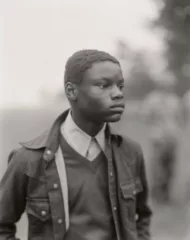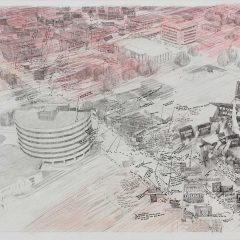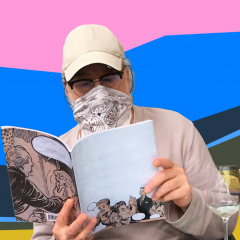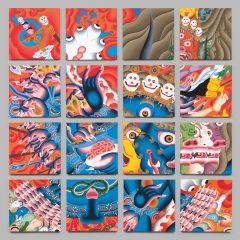In 2007, Gilbert & George mounted a massive retrospective at the Tate Modern that included “Mullah.” The tremendous work (2.42 x 2.02m) from 1980, featured a stone-faced icon seemingly cast from the Magic Forest. Composed of photographs of cut planks of wood (knots for eyes, nose and mouth) and collaged together in Gilbert & George’s signature multi-panel digital print in black and white, the work seems prescient these days as “mullah” gains traction across the Internet following the violent crackdown on the post-election street demonstrations in Iran.
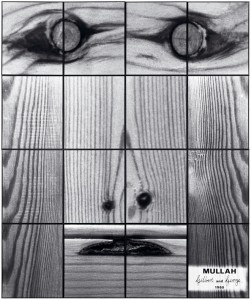
“If you cut down a tree and make a table, it will always remain the same, forever,” they explain. “So we made the face of the mullah out of cut wood. It’s hard and fixed, like those Christian and Muslim fundamentalists who would like the Bible to remain as it is forever.” (read more at the Tate Modern website.)
Sitting with Gilbert & George hours before the opening of The Jack Freak Pictures at Thaddeus Ropac Gallery in Paris. Jack Freak? Jack as in Union Jack, and Freak as in their brand of every man Brit.
I asked them if they’d like to do a show in Iraq…or somewhere in the Middle East. “No, not in Iraq, no. We would however, very much like to have a show in Iran, “ says Gilbert. “The revolution is with the young people, not with the politicians,” adds George.
Revolutions, anarchy, protests of all flavors, religion, sex and norms-upended are part and parcel of the immense oeuvre Gilbert & George have put together over the last four decades. The Jack Freak Pictures, 153 large-scale works in all, are no different.
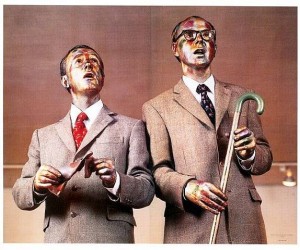
The British art duo who launched their career as singing (living) sculptures during the inauguration of Ileana Sonnabend‘s New York Gallery in 1971 with an eight-hour rendition of “Under the Arches,” are out on the street themselves with The Jack Freak Pictures, seeking to “de-shock” (their word) the Union Jack, as they’ve done to Christ on the cross, shit, urine, sperm, nakedness and dirty words.
In most all their works, the two often appear, as protagonists (clothed or naked) in a kind of deadpan pop drama. Fingers, eyes, noses and other difficult to identify body parts are reconfigured in a re-imagined “British” world. In these dense, fetishized works, Gilbert & George are plainly visible, looking slightly worried, bored, or at times delightfully goofy, witnesses to the maelstrom that issues from Christ and Country.
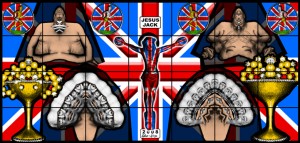
These Jack Freak Pictures attempt to make sense out of the nonsense of repetition of the flag – any flag, really – that turns on it as a linguistic unit. The “flag” is a word, a phrase or better, an utterance; and in these pictures, the flag is a visual tic. One has to reconsider the phrase “God and country.” There’s an overt and intentional banality to the colorful display that is strangely beautiful and weirdly charming.
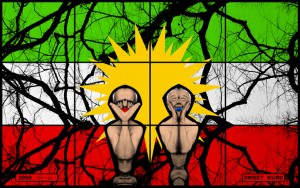
But not all the Jack Freak Pictures refer to the British Empire. “Sweet Kurd” (2008) is an ode to the pair’s favorite eatery (which closed this year) and perhaps their favorite meal? Each evening for the past 11 years Gilbert & George made their way down from their home on Fournier Street in Spitalfields, London, to the Mangal II.
“We eat out every night in a Kurdish restaurant – and they are Alawi,” says George. “These are the Quakers of the Muslim world and they are completely discriminated against.” (George tells me that his front door on Fournier Street is repeatedly pelted with rocks by his not-so-friendly Muslim neighbors.)
The fact that politics has be sleeping around with religion more and more these days, is an idea never far from G&G’s tongue-in-cheek visual essays. Their work variously recalls the shamanistic and quasi-religious performances of Joseph Beuys (“Everyone is an artist”), and is often compared (via the tonnage of crucifixes) with Andres Serrano‘s “Piss Christ.” But G&G perform with a high-gloss, camp attack: They look out from these immense works like post-war bankers or accountants, economic crisis be damned.
They at least are working hard; some intrepid art bean counter calculated that the two have made one artwork every 12 days since they teamed up at St Martin’s in 1967. Their messages are beautifully rendered tens-of gigabyte-beauty, kaleidoscopic visions of a mad, mad world.
In 2002, Guardian art critic Adrian Searle wryly noted “Now entering their 60s, Gilbert and George might almost be described as a national institution, if not a national treasure, were it not that such descriptions would diminish them, cauterize their art and turn them into respectable buffoons.”
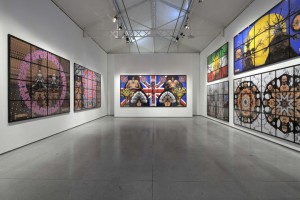
Artists like Jasper Johns and others have long dealt with national symbols in ways less than flattering to their nations. After 9/11, the American flag itself had a new litter of meanings — which only seemed to multiply the power of Johns’ flag paintings.
In today’s works, many countries flags are made in China. Nationalism by the pound.
For Gilbert, the Union Jack is “a gift for us – with its crosses!” Adds George, “Still, the American flag is the only one that is regularly burned.” I wasn’t sure if he wasn’t a bit jealous. “But most flags,” George assures me with Gilbert nodding in agreement, “are inside people.”
The Jack Freak Pictures are spread out across seven European galleries and will probably do more for UK Tourism than BBC World news. It opened in Berlin at Arndt & Partner in June (to 23 August), and then in Paris at Thaddeus Ropac (to August 1); the tour continues on to London, Brussels, Salzburg and Athens, finishing up in Naples on February 6, 2010.
–Matthew Rose is an artist and writer based in Paris. His current project is: A BOOK ABOUT DEATH, and unbound book on the subject of death for The Emily Harvey Foundation Gallery, in New York.


